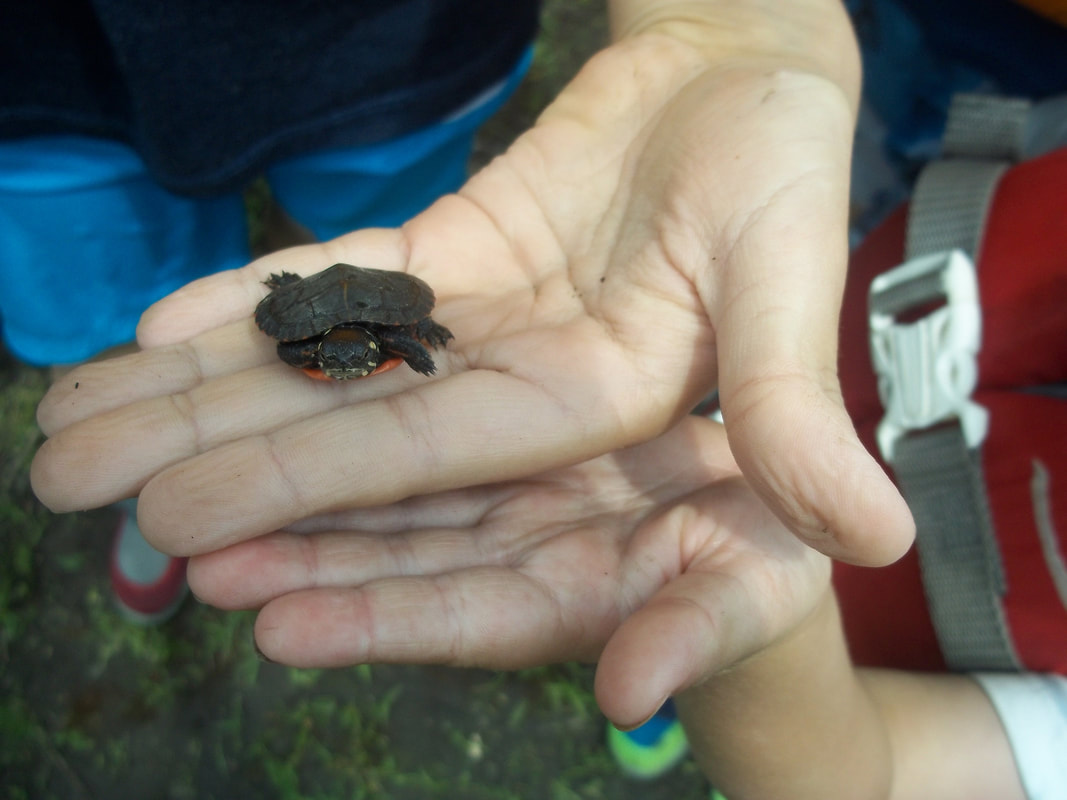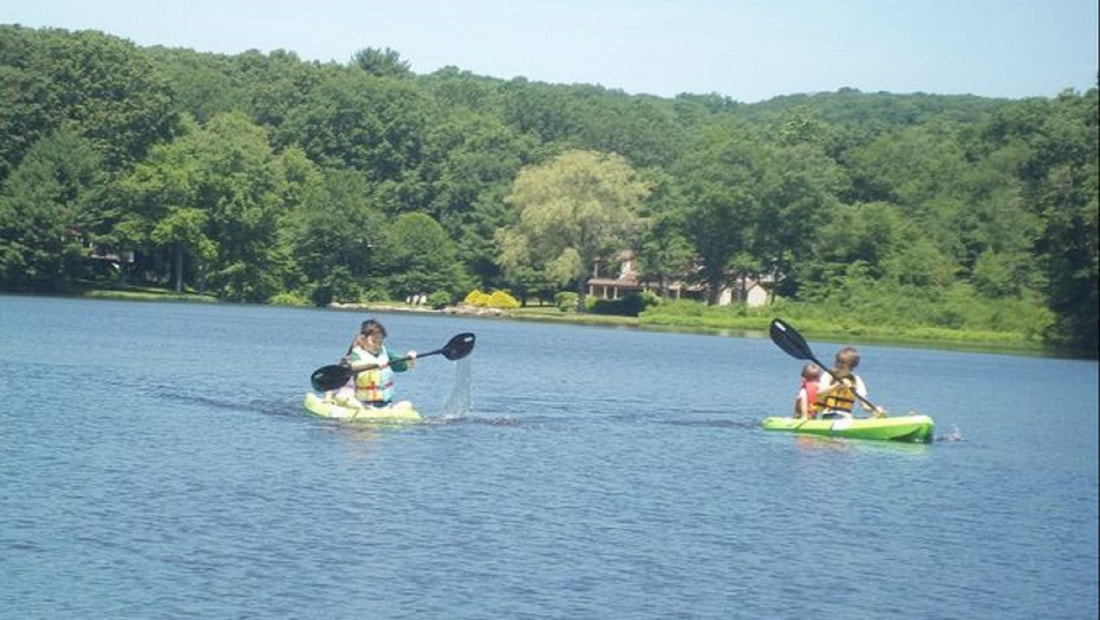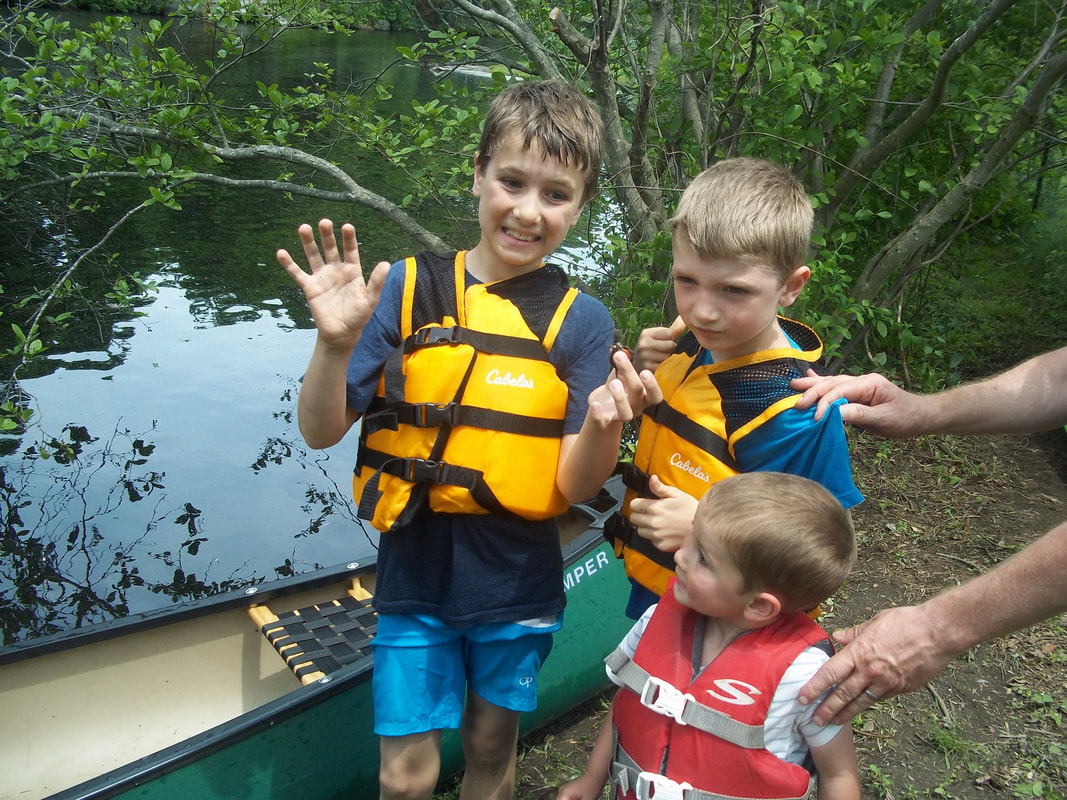Kid Kayaking Best Options for your Child's First Kayak: Sit-on-top, Sit-inside, or Inflatable?9/4/2018
(...and also, to Tandem or Not to Tandem) What kayak is best for my kid? You have decided kayaking is something you want to look into for your son or daughter, but where do you start? What kind of kayak should you choose? Should you get a sit-on-top or sit-inside? A hard shell or inflatable? A solo kayak or tandem? What style of kayak is the safest, most comfortable, easiest to use, or most affordable? When we decided to get our young kids started in kayaking, we realized that there are a surprising amount of choices! When it comes to kayaks for young kids, keep it simple. Getting more information can help you feel confident that you are choosing the best option for your situation. Your child doesn't need anything fancy, he or she just needs to get started. Read on for tips to point you in the right direction. The hardest part is getting the information and making a choice. After that, the kayak shows up, you check the weather, pick a day and pack a bag (more on that in another post!). It is all downhill and lots of fun after today. We are cheering you on! SIT-ON-TOP KAYAKS: FUN, EASY 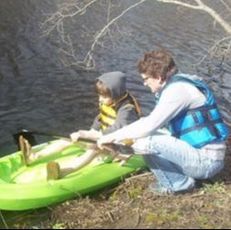 Sit-on-top kayaks are my first choice for very young kids age 5 to 10 and most beginners of any age. They feel like a personal raft and kids think they are a blast. I have not had even one kid try our sit-on-tops that didn't succeed within a few minutes and not have a great time. As water splashes on the kayak, scupper holes drain the water out, so there is no need ever to drain or pump water out. They are easy to get on and get off. There isn't any of the fear of "getting inside" the sit-inside kayaks that some younger kids have. There is no feeling that they could tip, get trapped, or get water in their vessel. They are wide and stable. Kids can sit with their legs straight, bent, or crossed. They can even take a nap, fish, jump off and swim and climb back on again. Sit-on-top kayaks are childhood at it's best, in my opinion. They are also cheap, easy to store, move, and have delivered. They are like a giant toy in boat form and make a really cool and impressive birthday or Christmas gift. When a child outgrows their first sit-on-top kayak, they can then try a traditional sit-inside kayak next, or maybe they will get another sit-on-top in a larger size. If your family will kayaks for play - exploring, fun, and swimming (think- summers at the lake) versus for traveling long distances or in difficult waters, then the sit-on-top is king for families with kids just wanting to have fun. They will get wet, and they will have fun. However, If you live somewhere cold, plan on traveling significant distances in your kayak and need to stay dry and warm and have extra storage, then you will want a sit-inside kayak for your child instead. SIT-INSIDE KAYAKS: DRY, FAST, LOTS OF OPTIONS 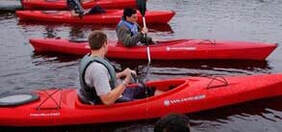 If your child will be kayaking in cold water, in cold weather, or somewhere that water will be splashing up on them at times (and they want to be dry), they will need a sit-inside kayak. With this style, you can stay warm and dry, and you can travel longer distances. Think of the sit-inside as a vessel for travel and exploring more than as a lake toy (sit-on-tops). You have more control than in a sit-on-top kayak because you have more contact points with the boat to push against, making your strokes more powerful. The downside is that you can't jump in and out to play in the water like you can with the sit-on-top kayaks so you will want to think about the age and temperament of your children and what would be the most appealing experience for them, the temperatures, and where you will be using your kayaks. Generally, wider shorter kayaks (recreational) are slower but more stable while longer narrow kayaks (touring) are meant for speed and distance. Some kayaks are built for the ocean (sea kayaks) which are very long. Recreational kayaks are great for families wanting to explore at the lake or on a calm river. Touring models are more expensive, often made of better materials to make them lighter and sleeker, and also require more care. The more money you spend on a sit-on-top kayak, the more features it will have to increase your comfort and efficiency while paddling. While the sit-on-tops are pretty basic and straightforward, with traditional sit-inside kayaks there are many more levels of materials and features from which you can choose. The more you spend on a kayak, the higher quality the materials will be and the lighter the kayak will be. For getting kids started, I wouldn't worry too much about getting an expensive kayak if you are on a budget. In the beginning, it is always best to keep things simple while you try things out and have fun with your kids. If you don't spend too much up front, you will focus more on having fun than worrying about your expensive gear. I'm all about a smooth entry into a new hobby. Keep it simple. Take the option that makes sense for your situation. Get started now. Get a used kayak even. Each day we have is precious. Whether it is getting a kayak or something else, take action and go for it. It is probably much less complicated than it feels. Too many options can paralyze us, so I say good-enough is more than good enough if it gets us started! If it leads you and your kids somewhere new and exciting, it was worth it to take the risk. Once we are enjoying something, we usually wonder why we waited so long! Okay, back from my side trip: You can buy sit-inside kayaks in a hard shell or as an inflatable. You also have the choice of solo or tandem (one paddler or two). On this website, I am suggesting parents new to kayaking consider solo kayaks to give kids the chance to have the independent feeling of exploring on their own. I've seen my kids blossom by having their own kayaks and using them on calm water, and I want this for other kids, but I recognize that a tandem kayak has its place. Parents may wish to kayak with a baby, toddler or young child with them in the cockpit, or a special needs child (such as my own) can ride with a parent in a tandem kayak. For all situations when it is possible, I strongly recommend getting everyone their own kayak. It is so much fun when kids have that autonomy. You will see your kids grow in ways that will surprise you. Their self-esteem will increase as they handle small obstacles on their own. When they are ready, and your circumstances are appropriate, go for a solo kayak. Some things to know about sit-inside kayaks are that they can get tipped over and filled with water, or take in water in other ways, while a sit-on-top can not. You will need to know about skirts, bilge pumps, and how to do a wet-exit in case of emergency at some point if your family is going to get into sit-inside kayaks. Features such as foot pedals, rudders, and skegs help you go straight when it is windy. More expensive seats and bigger cockpits can be more comfortable. You will also want to be aware of how much storage is available depending on how you plan on using the kayak. Different hulls (deep or shallow, wide or narrow) have distinct advantages depending on your goals. As you can see, there is a lot more to consider when you are buying a sit-inside kayak. These kayaks are the traditional kayak, and the sky is the limit with what you can do. However, if your kids are young and if your family has not kayaked before, may I suggest starting with either a sit-on-top, or if you do choose a sit-inside kayak, buy a recreational wide cockpit style that will be easy and fun to use. Your kids won't be paddling very far in the beginning, so they don't need anything complicated. When things are too technical in the beginning, it is easy for anyone to get deterred, and I think this is especially true with kids. As their strength, skill, and knowledge grow, you will know when they are ready for more. INFLATABLE KAYAKS: VERSATILE, CHOOSE SIT-IN, SIT-ON, TANDEM OR SOLO 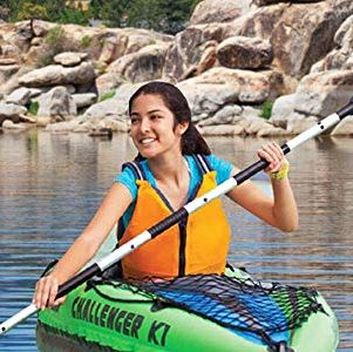 Ahh...the Inflatable kayak. Modern-day ease at it's finest! The inflatable kayak (and inflatable everything) allow people in cities, those with small cars, or anyone living in apartments to not be excluded from the world of outdoor adventure sports. When one isn't limited by needing space to store outdoor equipment, the world of this sport opened it's doors to more families! You may be asking: Are they safe? Are they durable? Do they work? Yes, yes and yes. They are surprisingly durable, they work, and they are safe (as long as you are using them as intended and appropriately). They are affordable, and they leave no excuses for why you can't get your kids (even teens) in a kayak. You can do this! Even if you have no space, even if you have a small car, you can take your kid kayaking. Most inflatables come with a paddle and a pump. The pump is usually a hand-pump, which I will confess is a pain for impatient people like me. If you are more patient than I am and don't mind hand-pumping for 10 to 20 minutes, then use the pump it comes with or have your teenagers do it. Many people order a battery-powered pump to make inflating and deflating fast and easy. Most people are skeptical about inflatable kayaks (and inflatable anything) but are pleasantly surprised at how well they work and how much fun they have for such a small price tag. This past year my family bought an inflatable hot tub (yes, this is a real thing, and it's awesome!) and an inflatable dock. We are from Idaho (land of hot springs!) and now live in Connecticut. Since there are not hot springs here, and as renters not wanting to invest in an expensive hot tub, we ordered the inflatable, and it is shockingly strong material (and works surprisingly well!). We also ordered an inflatable dock for our riverbank, not wanting to build an expensive metal and wood dock, and it has been so fun to use with all of our water toys in the river. We are impressed with the strength and quality of this technology of inflatables, as skeptical as we all tend to be at first! So if inflatable is the option that makes the most sense for your family and situation, go for it! I think you will be pleasantly surprised by the price and the quality, and how much fun you have. A NOTE ABOUT TANDEM KAYAKS Tandem kayaks are built for two or more passengers. Sometimes tandem kayaks are a perfect option for your situation.
If any of the above describe you, then you may be in the market for a tandem kayak! But for all others, I recommend considering solo kayaks. If your child is able to paddle alone and you are going to be on calm water, I think it is very beneficial to get them a single-person kayak and let them explore. Even if you need to start out with a tandem kayak, at least have it be your goal to get them there as soon as you can. A big world opens up to a kid when they can paddle their own kayak. Something most people don't realize about tandem kayaks is that some styles can't easily be used solo, if at all. Shorter wider tandem kayaks with one large cockpit can often be reconfigured so that they can be handled by one person. However, it is also harder to coordinate paddling with another person in this style of kayak. Longer tandem kayaks with cockpits spaced further apart can be very challenging or near impossible to paddle alone, not to mention very heavy to lift by yourself. One of my sisters started with a tandem kayak when she was in her twenties, only to trade it in a few years later for a solo. She just wanted to be able to use her kayak whether she had a passenger available or not and it was fast and easy for her to take the solo out by herself after work. Also, there is a reason that tandem kayaks are lovingly (or maybe not so lovingly) referred to as the "divorce kayak" or "divorce boat." It is because it takes a lot of communication to work together effectively! I'm not saying that is 100% negative, but it is something to be aware of for sure. Maybe you just want to work on your kayaking right now and not your communication. Perhaps you want to work on both with your teen or spouse, or teach a younger child some paddling skills. It's up to you. I just want to go kayaking! Now if your family is hard-core and you will be camping multiple days along the water while touring, then tandem kayaks may be for you! Young kids can't paddle as far on their own and would need to be with an adult for those types of trips. If you are a mom or dad wanting to start kayaking with three kids under the age of 5, then tandem kayaks are for you! Or of course, you could get a solo kayak for you and your husband, put one toddler in each cockpit with each of you, and a get a Lifetime sit-on-top child kayak for your almost-5-year-old. Just saying that's what I would do! But some people may be thrilled with a tandem kayak in that situation for sure. If you have a baby and want to go kayaking with your spouse, get a tandem, please. Also, some kids will never be able to paddle alone (my son with disabilities), so obviously there are some situations where you really need a two-person kayak. For recreational play in lakes and rivers for kids 5 and up, I vote for solo kayaks. Also, for spouses that want to stay married and enjoy roasting marshmallows together after a beautiful day on the lake, again, I vote for solo kayaks. My husband and I lovingly KNOW we can't paddle together if we want to have a memorable day free of arguing. Try paddling with your spouse, and you will see what I mean! All fun aside, maybe you and your spouse already successfully paddle together or will do fine paddling together! If you think you could ride a tandem bike with your spouse, would enjoy riding a tandem bike with your spouse, or do a three-legged race together, then buy a tandem kayak! Consider the same criteria for your kids. For some, this sounds fun, and for others, it sounds like misery - so choose accordingly! How independent are members of your family? Every family and situation are different. For some families just getting started with very young kids, a sit-on-top tandem kayak is a lot of fun. I hope it came through in this section that even though tandems aren't my favorite way to kayak, they have their place and work very well for some people and in some situations. I may need to reread this section and edit my opinion out a bit more! A final note: if you are touring long distances on kayaks, then having more kayaks out on the water can mean that there is a second (or third, etc.) boat to go for help or help others in case of an emergency versus being far away with just one tandem kayak. So what type of kayak will work best for your child or for your family?
Whichever type of kayak will work best for you, your kids, and your family, GO FOR IT! Get started! Kayaking is affordable, fun and good for you in so many ways. Happy Kayaking! |
Categories
All
Our FamilyAlmost six years ago we moved into a little New England house with a river in the backyard and quickly discovered the joy of kayaking kids. |
You may also be interested in:
Legal Information: This site is meant as a log of our family's opinions and experiences, but is in no way a comprehensive safety guide for kayaking. Kayak at your own risk and research well anything pertaining to your family's safety. This site shares our experiences and products we have tried and researched. There are affiliate links used to reference the products being reviewed.

 RSS Feed
RSS Feed

